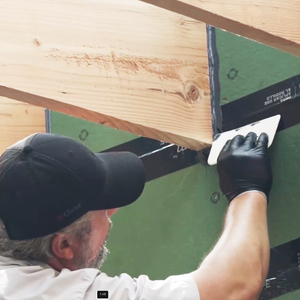Does anyone have any experience using quartersawn T&G flooring with radiant heat (installed under the subfloor)? I’m thinking of yellow pine, or maybe antique heartwood. I’m trying to find out if it will shrink and/or expand less than regular flooring. I mfind that if I ask the people who sell the flooring they will tell me what I want to hear. I know there’s a lot of radiant heat being used these days, so someone must have some advice. Help, I have to make a decision soon.
Discussion Forum
Discussion Forum
Up Next
Video Shorts
Featured Story

There's a constant source of clean water for you to use, and all you have to do is collect it.
Featured Video
SawStop's Portable Tablesaw is Bigger and Better Than BeforeHighlights
"I have learned so much thanks to the searchable articles on the FHB website. I can confidently say that I expect to be a life-long subscriber." - M.K.

















Replies
I've got about three thousand feet of high quality qtrswn heart pine over radiant on jobs I've done. It is extrememly stable.
But
I'm talking about true quarter sawn vertical grain with a minimum of 12 growth rings per inch.
I would be sceptical about using SYP in this way and the good antiqyue is almost impossible to find. Last batch I got, I wrote specs for it and got a price quote of $10.40/sf. After delivery, the broker told me that if he known how hard it would be....next order to those standards would be more like 20/ft.
I'll see if I can find pictures on my floppies later.
This atachment is an older scetch showing why vertical grain wood is more stable, as a general rule.
Excellence is its own reward!
Sorry- no photos left of that stuff - lost in the crash.
Excellence is its own reward!
Thanks for the sketch. That makes it real clear why to use quarter sawn.
But how much did it cost to get 12 growth rings per inch, and how available is it. Where did you get it?
Last order had rings of 12-18/inch in legths of 6' to 18' I shop it to a lumber broker who does the calling around. That lot cost $10.40 (easy number to remember on April 15th)
.
Excellence is its own reward!
Whatever flooring I use, it's going to get nailed. With my hydronic tubing running between the joists, it seems like I'm restricted to nailing on the joists only, and all my butts are going to have to be over joists. Is this sufficient? Usually I nail between the joists too. What about using mastic too, without floor paper??
The ones we used mastic on were over hydronic. We used shorter staples is why. I also marked with crayon where all the tubes were located and stayed away from .
Excellence is its own reward!
I, too, am about to install recycled antique heart pine over radiant heating (Wirsbo Quik-Trak/Stadler Climate Panel), but I'm getting very different opinions about acclimation. I has an amazing number of rings but is very sappy. It came from a 100 year old mill in Providence, RI. I have some questions though.
What are you doing to acclimate the wood floors? What moisture content do you think is necessary for the recycled pine?Are you doing anything special regarding nailing to minimize movement? Finally, what finish are you recommending, particularly for a busy family?
Thanks,
Ron
Sappy - They used to process turpentine out of this wood. It isn't all so waxy but the floor finishers hate it because it gums up the paper so quickly. They usually mention it and I keep them happy with an over charge for a case of extra paper. We alweays use Oil based polyurethene on it. The wood itself is full of the oil and the oil based brings out the beautiful warm amber tones. I did one once with water based poly and it looked like you laid a sheet of plastic on it - ugly. I also did one small landing with tung oil and I liked it best but that was slow curing.
I don't pay so much attention to moisture content. I sticker and stack in the rooms it will be installed to with fans blowing over the pile for three weeks before we start laying. (and after the sheet rock and primer painting so it won't absorb the same water that is coming out of the walls drying) The same resins (sap, wax) that preserve this wood for the ages and make it hard to sand and finish also help prevent it from absorbing much moisture. IMO, that is what makes it stable besides the close growth rings.
It gets normal nailing for any wood floor. We did some with glue and some without but all got nailed..
Excellence is its own reward!
I'm assuming this is over radiant? I had this stuff stacked as you said in a trailer for about a year. When we opened the trailer about a week ago, it almost knocked our socks off with the wonderful odor of pine.
But which oil based poly do you recommend for our highly active family, and what application procedure do you suggest.
Incidentally -- I've heard some folks suggest that the poly is not recommended over radiant because it creates an inflexible skin that "pops" when heat is applied.
Thanks,
Ron
I won't specify any particular brand. Someone else here who specializes in floors might.
There is some truth to that suggestion. You need to let it cure well before turning that heat on. We had one that had the heat running while finishing. It turned out to be a soft finish.
Theroy we come up with after several conversations, is that the coat of finish can skim over too quick with higher heat. That skim prevents oxygen from getting to the mass of the fluid in that coat. Do that three times and you have created a gel coat layer on top of the wood. Dog nails scratch it easier than other floors in the same house..
Excellence is its own reward!
Piffin's pretty much covered it.....as usual. I'll add one thing to his advice and you likely won't want to hear this..........it takes approx. six to eight weeks for that oil-based poly to fully cure depending upon the thicknesses involved. You may not have to wait that full amount of time to turn on the heat, but don't assume that the finish is cured just because it feels dry to the touch or doesn't feel all that soft under finger pressure. Knowledge is power, but only if applied in a timely fashion.
I'd say 3-4 weks is more like it, depending on ambient temp and humidity.
I was also referring to curing between coats for a good 48 hrs, otherwise the middle coat is trapped between firsy seal coat and final top coat to gel..
Excellence is its own reward!
I've heard several people extol the virtues of High Resin Tung Oil, particularly for antique heart pine. They claim it's quite water resistant, trouble free, is prettier than oil-based poly, and less likely to suffer from panelization particularly over radiant.
Any thoughts on this? Particular brands? And I would love to hear some specific brand recommendations on oil-based poly!
poly tends to be more of a surface film, as I understand it. True tung oil is the basis for a lot of rubbing oils. It penetrates the wood and cures slowly by oxidation instead of evaporation. It was once favored for wooden boats, especially below water areas. Because it doesn't film, a tung oil floor is easier to repair scratches on. The rubbed in repair will blend but with poly, the patch looks like a patch..
Excellence is its own reward!
Ron,
Oh Lord, here comes another long post………………..forgive me, please.
My only experiences with the use of straight tung oil is on furniture pieces and I quit using it on those many years ago because it just didn't perform up to my needs or standards. I think the appeal of using straight tung oil finishes to the masses at large is because it invokes feelings of old world craftsmanship and the associated mental romance of "hand-rubbed" finishes………whatever that means; another romantic notion, I'm afraid. The only true hand-rubbed finish I'm aware of is French polishing and there's not much of that going on in the furniture industry anymore despite the beauty of it.
I can only speak to the straight tung oil finishes I've used and here's what I can tell you…….. while it can be made fairly water resistant with the application of five or more coats, it offers virtually no barrier from the exchange of water vapor and so you can count on having the maximum amount of moisture-related movement in the wood. The coats must be applied rather slowly and you should scuff the surface between coats. Those coats must be applied sparingly because if it's left to dry in much of ####film at all, it will dry with a whitish haze to it and there's no removing that haze without stripping the finish off and starting over. The first few coats will dry looking rather splotchy, so if you try this, don't be alarmed by that development. It does have one potential advantage over boiled linseed oil and that is that it doesn't yellow nearly as much, but like any straight oil finish, it isn't a very hard finish.
If this is the stuff that's available to finish floors with today, I wouldn't be inclined to use it as it certainly wouldn't stand up to the rigors of our household. I'm sure there's folks out there who would care for it adequately to protect it, but that wouldn't be here in this house as we don't remove our shoes prior to entering. I guess I'm not a big fan of "oil finishes" on floors…..period…… I see myself spending many hours doing maintenance.
Tung oil is used in the manufacture of nearly all varnishes but it's seldom used alone/straight as a finish by folks who know finishes. Straight tung oil has been available for eons and I'm sure that's why they make varnishes, lacquers, and other finishes. IME………yes, it's easier to do spot repairs on tung oil than on poly and it's nearly guaranteed that I would if I used it on our floors.
Polymerized straight tung oil would perform more like a varnish, offering better abrasion protection and water vapor resistance. There are sources for polymerized tung oil but I don't know where to send you looking for them unless these tung oil floor finishes today are the polymerized product.
Our large kitchen floor is old-growth VG heart pine installed in 1875. We put three coats of Valspar oil-based satin poly on it in 1989 and haven't touched it since except for routine cleanings. To each his own, but I wouldn't walk on a piece of furniture finished in tung oil and expect it to last all that long……..and that's what a floor is…same wood material………only underfoot.
Knowledge is power, but only if applied in a timely fashion.
"P"
You are one of the few people to know the importance of proper machining of the product. That little gap on the underside, along with expansion as you mentioned, also allows a tight fit when traversing a hump. "Murphy" always makes sure that humps fall under the joints of two boards. Another important space occurs at the tongue and groove. I like to fit two pieces together, sight through the bond and see 1/16" daylight at the other end, and nice rounded tongues, not square.
There are lots of small shops in my region putting out flooring. This stuff is run on one knife shapers, passed through 3 or 4 times to make all the cuts and tends to be very sloppy. A lot of homeowners buy this crap because they don't know any better. They think flooring is flooring is flooring. Why spend $3.00 a sq. ft. when some Amish guy sells it for $1.50?
Ya get what ya pay for. Ditch
Yeah! A lot of folks try to mill it themselves too with a standard set of T&G bits which are to ensure a tight glue fit on both sides, say for a door or other panel work. The flooring T&G bits are completely different..
Excellence is its own reward!
one floor sander I know calls this stuff "bathtub pine", cus he can fill up a bathtub with all the sandpaper that fill up with resin.listening for the secret.......searching for the sound...